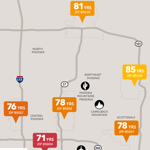Short Distances to Large Health Gaps
 It’s a quick drive from Scottsdale to South Phoenix, but when it comes to health the two communities are worlds apart. If you are born in Scottsdale, you can expect to see your 85th birthday. In South Phoenix, children are likely to only reach their 71st.
It’s a quick drive from Scottsdale to South Phoenix, but when it comes to health the two communities are worlds apart. If you are born in Scottsdale, you can expect to see your 85th birthday. In South Phoenix, children are likely to only reach their 71st.
This shocking difference was made clear in a new map released this week by Virginia Commonwealth University and the Robert Wood Johnson Foundation. The map—which shows life expectancy by ZIP code across the Phoenix region—demonstrates short distances between large gaps in health. These organizations have been mapping communities around the country, and Phoenix is no different than other regions they have analyzed.
Where we live affects our health and well-being far more than most people realize. The new map provides stark proof. In many cases, our ZIP code is a more important indicator of health than our genetic code.
Many factors contribute to the differences. Quality education and the opportunity for well-paying jobs are two examples. Access to affordable, quality housing and healthy foods are two more. Transportation has a role too. From sidewalks to light rail, how we travel can be a prescription for vitality, or it can isolate residents and cut off opportunities for well-being. It’s the same with food, housing and education. Where there are mostly lower-quality options, residents are less likely to lead healthy lives and more likely to have a shorter life expectancy.
At St. Luke’s Health Initiatives, nearly 20 years of experience has taught us that health is improved by working together to invest in the places where we live, work, learn and play. Lately, we’ve seen collaborations arise from sectors such as housing, transportation, community development, economic development, and health care. Over time, each of us has come to realize that these areas and their issues are interconnected. Why work in silos then, when our outcomes are so interdependent?
Our best chance for closing the life expectancy gaps this map shows will come from collaborations. You can start with the Arizona Partnership for Healthy Communities, which includes more than 30 partners from housing, transportation, community development, economic development and health who collaborate on improving health and well-being. In addition to St. Luke’s Health Initiatives, founding members include the Federal Reserve Bank of San Francisco, the Arizona Housing Alliance, and Local Initiatives Support Coalition of Phoenix. Also, the Arizona Alliance for Livable Communities’ mission is to educate, engage, and encourage communities and decision makers to transform cities and towns in ways that improve health, livability, and wellbeing. Through a range of efforts and investments, we are starting to see meaningful changes that could help change the health gaps our region faces.
Twelve miles shouldn’t add up to a 14-year difference in life expectancy. It’s time to connect and invest in order to #CloseHealthGaps, because a stronger Arizona comes from healthy, growing neighborhoods, no matter what the ZIP code.